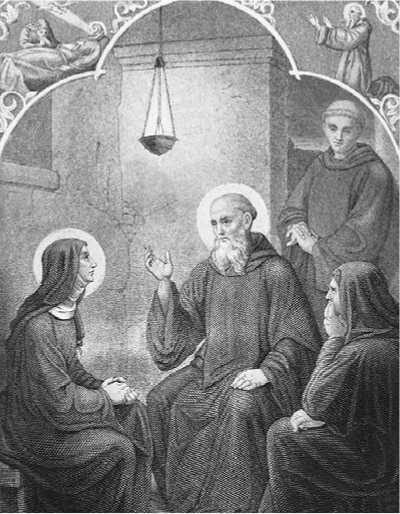It would be ironic indeed if this most un-innocent of men had been given that name at birth, but in fact he was born Lothario de Segni (SAYN-yee). Like many another pope, he came from an Italian noble family and received the finest education available at what were then Europe's two greatest universities, in Paris and Bologna (buh-LOHN-yuh), Italy.
It was one of the many curious facts of Innocent's career that he had not even been ordained, or formally appointed, as a priest when he became pope at age thirty-seven. He had reached the position of deacon, an office in the church below that of priest, when he was twenty-seven. Three years later, thanks in large part to a good relationship he had culti-

St. Benedict of Nursia (center). Reproduced by permission of Archive Photos, Inc.
Merly the site of a temple honoring the god Apollo. Later his sister Scholastica es
Tablished a convent, a place for nuns, at Monte Cassino.
Benedict died in 547, but the Benedictine Rule—that is, the system of life he had established for his monastery—long outlasted him. During his time, monks had tended to apply a variety of systems, some even more severe than Benedict's. Benedict discouraged his followers from going to the kind of extraordinary measures taken by lone figures such as Simeon Stylites (see box in Augustine entry). Other monastic systems emphasized the relationship between the monks and their leader, whereas Benedict's placed its emphasis on the relationship between monks. As pope, Gregory I heartily approved of the Benedictine Rule; and by the 800s, it became the prevailing monastic system in Western Europe.
Vated with Pope Clement III (ruled 1187-91), he was promoted to cardinal, the highest position short of pope.
Cardinals took part in the elections of popes, and Lothario's colleagues voted him to the church's highest position upon the death of Celestine III in 1198. He then chose the name of Innocent, and six weeks after his election was hastily ordained as a priest.




 World History
World History









